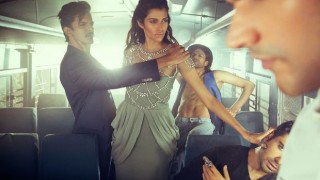
The horrific gang rape and murder of a woman on a bus in Delhi in 2012 shocked India and the world. While there was a huge outcry at that time, little has been done in India or elsewhere to curb men from viewing women as objects and subsequently hurting them. Now, a photographer named Raj Shetye has glamorized, fetishized and glorified the 2012 gang rape attack in fashion photos that have caused an outcry on social media. Soon after Shetye posted the photos, people began noticing that the model bears a striking resemblance to the gang rape victim, and that the series, which he has named The Wrong Turn, clearly depicts the 2012 event.
Tweets began flying about, as well as Facebook comments, and eventually, Shetye removed the photos from his page. However, instead of apologizing for the way he chose to represent the attack, he made it all about himself by saying “It’s unfortunate that I am compelled to justify my artistic expression around a social issue.” He went on to say he was glad that his photos would “get the ball rolling” on the topic of social violence. If that is what he really wanted to do, however, he should have chosen a different way to do it.
Studies have repeatedly proven that when women fight back with aggressive, violent force against rape, chances are, they will not end up NOT being raped. In fact, the statistics are staggering: fighting back aggressively lowers a women’s chances of being raped to just 14 percent. Not fighting back results in rape almost 100 percent of the time. When are photographers going to choose to “get the ball rolling” on talking about fighting back instead of glamorizing and sexualizing rape?
Mr. Shetye, why not do a follow up series that depicts a woman successfully defeating her attackers with violent force rather than photos that show her in a subordinate position, forced to the floor, yet looking up at the rapists with what appears to be a mixture of fear and lust? If more images showed women violently fighting back (as in real-life cases where women have done so and escaped attack), and it became the norm for women to learn how to effectively practice self defense, up to and including killing their attackers, if needed, to protect themselves, fewer rapes would occur.
While few if any people in the U.S. would advocate censorship of art, no matter how abhorrent-we believe in free speech above almost all else-we can come together and tell artists how we feel about their repugnant choices. This choice was repugnant, but we can issue a challenge to Shetye and others to change. Everyone who cares about women and their safety can cry out for a shift in the conversation: stop depicting gang rape as fashionable and start presenting alternatives. How about a photo shoot where a woman goes into a Kill Bill mode and lays her attackers out on the ground with a swift kick to the groin and some martial arts moves ? Place the men in the subordinate position on the floor, because that works in real life to stop rape.
It always feels like too much to ask for, though, because no one ever responds to take up the task of promoting violent and aggressive self defense for women. Perhaps if artists with broad reach, such as Shetye, would answer to call to get the conversation moving in the correct direction, men would soon be taking a right turn instead of a wrong one.
